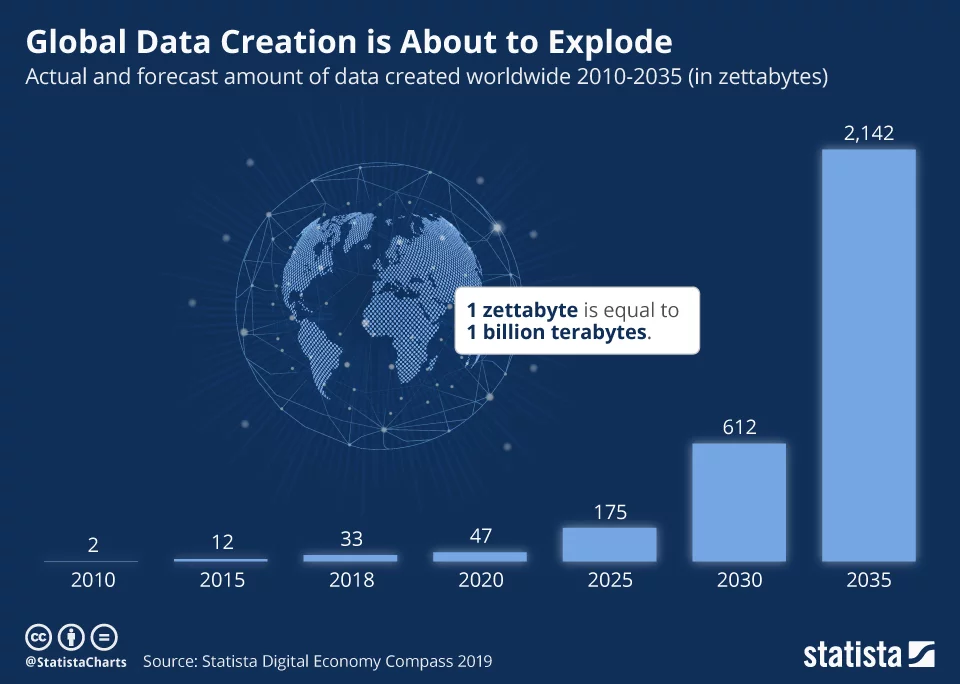Edge AI applications successfully merge technological phenomena that can revolutionize industries. Moreover, Edge AI applications help process and analyze data in real-time and ensure security while collecting and transferring the data. Further, AI algorithms and Edge Computing abilities benefit businesses by achieving higher productivity, accuracy, and protection.
Gartner’s article ‘Innovate With Edge AI’ states, “Edge computing and AI can raise innovation capabilities, operational excellence and customer engagement.”
Moreover, with the rise of IoT devices, and technological innovations, there is an extraordinary rise in data volumes. Further, a Statista report states that by 2035 the amount of data generated will be around 2,142 zettabytes globally. Therefore, businesses need an appropriate solution to collect, process, and easily access the data. As a result, Edge AI and its applications help with large quantities of data by using AI systems and algorithms with Edge devices.
Image Sorce from Statista Digital Economy Compass 2019.
Further, a market study by Markets and Markets states, “The global edge AI software market size to grow from USD 590 million in 2020 to USD 1,835 million by 2026, at a Compound Annual Growth Rate (CAGR) of 20.8% during the forecast period. Various factors such as increasing enterprise workloads on the cloud and rapid growth in the number of intelligent applications are expected to drive the adoption of the edge AI solutions and services.”
Hence, this article discusses Edge AI applications and their benefits to businesses.
Understanding Edge AI and its Applications
What is Edge AI?
Edge AI aka Edge Intelligence is an integration of Edge Computing and Artificial Intelligence that executes and monitors machine learning processes. Edge AI is an amalgamation of AI workflows that incorporate centralized data centers i.e. the cloud and devices as well as sources used by humans i.e. the edge. Although cloud AI develops and executes its functions completely in the cloud which is a more common practice. Further, Edge AI includes components like remote devices, IoT devices, and exclusive edge servers. Therefore, Edge AI enables data storage and computation, making it more accessible for users.
According to Michelle Duerst, Senior Director Analyst, Gartner, “The combination of edge computing and AI provides significant opportunities to survive in an increasingly disruptive world. Many executives do not understand how edge computing and AI can raise innovation capabilities, operational excellence and customer engagement.”
Moreover, Edge AI combines AI algorithms on local devices and implements edge computing capabilities. Hence, it enables data processing and analysis without connectivity and integrations, enabling users to access data from various sources. As a result, Edge AI blends the best of Edge computing and AI processes to mitigate downtime or latency of services. Further, it successfully merges AI processes as a pivotal component in Edge Computing devices. Therefore, it enables users to save time and cost by assembling data and supporting user requirements without interacting with physical locations.
How does Edge AI work?
Earlier, common AI applications were built using symbolic AI processes that encrypted rules into applications. For instance, AI algorithms are trained to detect fraudulent activities and expert systems to run operations. Further, optical character recognition (OCR) requires non-symbolic AI processes like neural networks to monitor numbers and texts.
However, over a period of time, researchers discover newer techniques to improve neural networks in the cloud. Moreover, there was an increase in inference, which refers to training AI models and creating responses for input data. As a result, Edge AI enhances the development and execution of AI processes outside the cloud. Therefore, Edge AI is a great solution for inferencing, and cloud AI trains new algorithms. Moreover, inference algorithms require minimum processing functions than training algorithms.
The basic components of Edge AI:
- Edge Computing: Firstly, Edge Computing includes multiple processes to collect, analyze, and process data at the edge of a network. That is to say, edge computing enables computation and data storage where the data is collected and located.
- Artificial Intelligence: Artificial Intelligence simply is the ability of machines to imitate human cognitive abilities. Moreover, abilities like comprehending languages and problem-solving skills are more common functions. Further, AI is an advanced machine that integrates enhanced analytical abilities with automation.
Advantages of Edge AI
With Edge AI, Edge Computing uses AI processes from the cloud to end-user devices. Moreover, it mitigates challenges in the traditional cloud environment like higher delays and lack of security. Therefore, the benefits of Edge AI increase opportunities for newer applications and processes.
- Firstly, Edge AI reduces latency and increases the speed of processing tasks. Further, it performs inference locally and mitigates any delayed communication with the cloud. Hence, it reduces the delay in response and results in the higher availability of systems.
- Further, it reduces bandwidth requirement and cost by processing it locally. Therefore transferring the data less over the internet saves internet bandwidth. Moreover, the cost of cloud service AI is higher in comparison. Hence, Edge AI enables users to utilize expensive cloud resources as post-processing storage systems. As a result, it collects data for future assessments, reducing the cost of real-time updates.
- Edge AI also offers high data security and reliability on autonomous technologies. Moreover, it processes the data locally, decreasing any risk that detriments the sensitivity and confidentiality of data.
- It also operates and executes functions during the downtime of networks or clouds. Therefore, Edge AI ensures the execution of critical functions for automation in applications like autonomous cars and industrial robots.
- Most Importantly, it uses less power by processing the data locally and saves energy costs. It also ensures high efficiency in power consumption by using less power to execute AI at the edge.
Applications of Edge AI Across various Industries
Edge AI applications are seen across various industries like manufacturing, healthcare, finance, transportation, energy, etc. Edge AI applications also increase horizons for newer innovations and business opportunities in various sectors. Hence, here are some of its applications:
-
Smart Energy: Intelligent Predictions
Energy is one of the most pivotal industries that directly or indirectly impact other industries. Moreover, the inconsistent supply and high demand intimidate the health and welfare of the entire population. As a result, Edge AI introduces intelligent forecasting for optimum results. Therefore, it analyzes historical data, weather patterns, etc. to generate complex simulations. Moreover, these simulations generate, distribute, manage, and monitor energy resources and their usage.
-
Building Smart Factories: Predictive Management and Monitoring
The manufacturing industry uses the latest technologies to improve and safeguard its processes and resources. Moreover, it also seeks solutions that enhance productivity, improve safety, and reduce risks. For instance, sensor data helps promptly detect anomalies and predict machine failure to avoid bottlenecks. Further, the sensor scan examines equipment and machine components for issues and notifies authorities. Hence, it avoids downtime and addresses issues that may lead to machine repairs and requirements.
-
Edge AI in Healthcare: AI-enabled Solutions
The healthcare industry is a necessary sector that improves the standard of living and increases life spans. Moreover, modern medical professionals and institutions use Edge AI for surgical practices. It also offers solutions for remote surgeries, diagnostics, and monitoring patient activities. Therefore, healthcare professionals utilize edge devices that implement AI at the edge.
-
Entertainment: Merging Reality with Technology
Edge AI applications in the entertainment industry may not be very upfront as it supports technologies like Augmented Reality, Virtual Reality, Mixed Reality, and Extended Reality. Moreover, these IoT devices interact directly with users for a seamless experience. Therefore, Edge AI supports basic computing, data analysis, and simple connectivity to offer various entertainment services.
Conclusion:
In conclusion, Edge AI applications ensure using advanced technologies to increase opportunities. Moreover, Edge AI applications display improvements in network bandwidth and enhance productivity.
You May Also Like to Read:
Artificial Intelligence Revolution: The Guide to Superintelligence


